Changing Compounds Open Vistas For Smart Mixing, Upgraded Technologies
- By Sharad Matade
- April 17, 2025

The tyre industry is undergoing a profound transformation, driven by sustainability, digitalisation and material innovations. As manufacturers push the boundaries with high-silica compounds, recycled rubber and alternative materials like dandelion rubber, the mixing process faces increasing complexity. Traditional methods struggle to maintain efficiency, necessitating advanced technologies like HF Mixing Group’s Tandem mixing and smart solutions. With automation, and precision engineering, the industry is redefining efficiency and sustainability.
Tyres are a sheer example of impeccable chemical engineering. From passenger car radials (PCR) to off-the-road (OTR), these technical marvels can carry loads weighing tonnes even in the deadliest of roads. For centuries, they have been the backbone of logistics, transportation and more.
But making a tyre is not an easy task. It involves a tremendously meticulous process ranging from raw material selection to mixing compounds for deriving the exact formula that gives these rubber casings durability, elasticity and more.
As the global tyre industry undergoes a transition in every critical aspect, it also sees a change in compounds that go into mixtures. This in turn paves the way for upgradation in technologies.
According to HF Mixing Director of Product and Services, Nils Spier, “The growing use of silica in passenger tyres is reshaping the industry with specifications now reaching 100, 130 and even 180 parts per hundred rubber (PHR). Levels above 150 PHR have recently gained traction, particularly in the premium segment, where high-performance tyres demand lower rolling resistance and improved wet grip.”
On the other hand, he revealed to Tyre Trends that increasing silica content presents technical challenges. Standard single-mixer setups face limitations due to the need for adequate silanisation time. When more silica is added, the process becomes more complex and time-consuming. HF Mixing Group’s Tandem mixing technology addresses this by transferring the process from an upper to a lower mixer, preventing capacity losses and optimising mixing efficiency.
“Dispersion is another critical factor as silica’s inherent stickiness complicates processing. The upper mixer completes the dispersing task, utilising a geometry established in the industry for over 20 years. The latest-generation PES7 mixer builds on this, ensuring the same high-quality results. Once the compound moves to the lower mixer, further refinements occur. A specialised bottom mixer rotor TRC, developed to enhance cohesion and compacting, helps mitigate issues where certain components tend to crumble. Without this step, batches risk fragmenting into plates and uneven portions, complicating further processing. The Tandem mixer’s rotor system ensures that the full batch remains intact, facilitating smooth transfer onto a mill or twin-screw extruder,” he added.
In a nutshell, the Tandem mixing technology allows tyre manufacturers to accommodate higher silica content without compromising processing efficiency or final product quality.
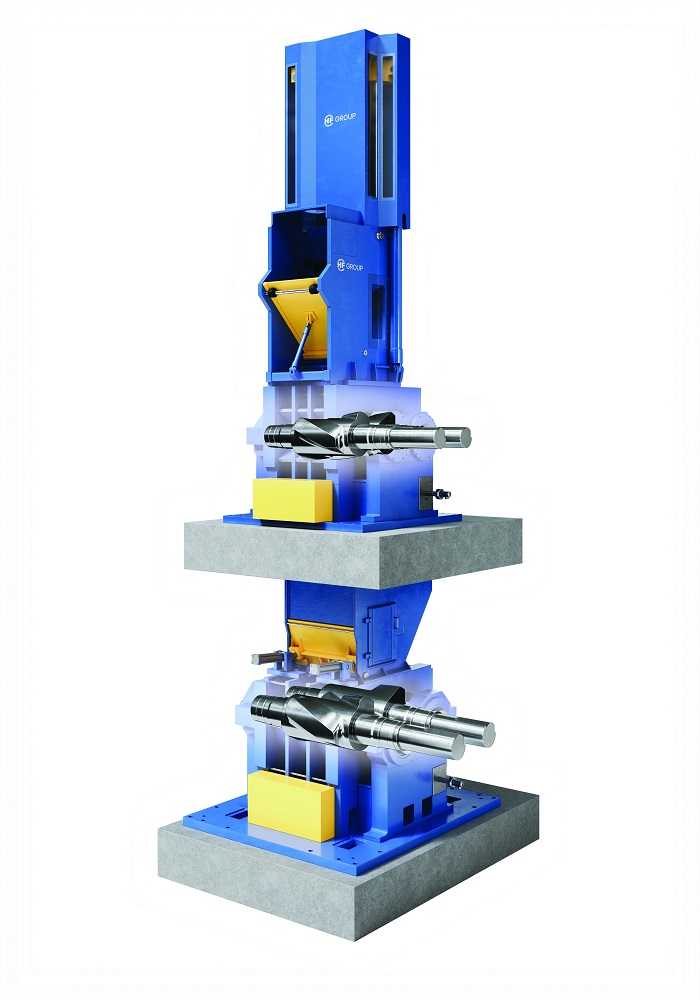
HF’s latest advancements in mixing technology are delivering notable efficiency improvements, particularly in intermeshing rotor systems. The PES7 rotor, introduced around two years ago, has now been successfully deployed at multiple customer sites, showing strong results in both new and retrofit applications. The rotor upgrade offers an increased mixer empty volume plus higher possible fill factors, resulting in a 10–15 percent increase in throughput without compromising cycle time or product quality.
UPGRADING MIXING TECHNOLOGY THROUGH SMART DIGITAL SOLUTIONS
According to Spier, “Tandem and the smart digital mixing solutions represent a holistic approach to optimising the mixing process. The smart final mixing solution is a software and service concept developed by HF, designed to work in close collaboration with customers. The process begins with defining the customer’s target recipe and process parameters, followed by calibration tests conducted on-site.”
Calibration tests involve capturing the fingerprint of the mix including rotor speed, drive data, temperature control unit settings and ram seating time. This data is then processed through the company’s proprietary algorithms and material models, which simulate various mixing scenarios to identify optimal process parameters.
The simulation models predict key variables such as batch temperature development at different rotor speeds and the impact of ram lift adjustments to improve compound aeration. This approach eliminates the need for extensive design of experiment, accelerating the optimisation process without compromising on productivity of the production equipment.
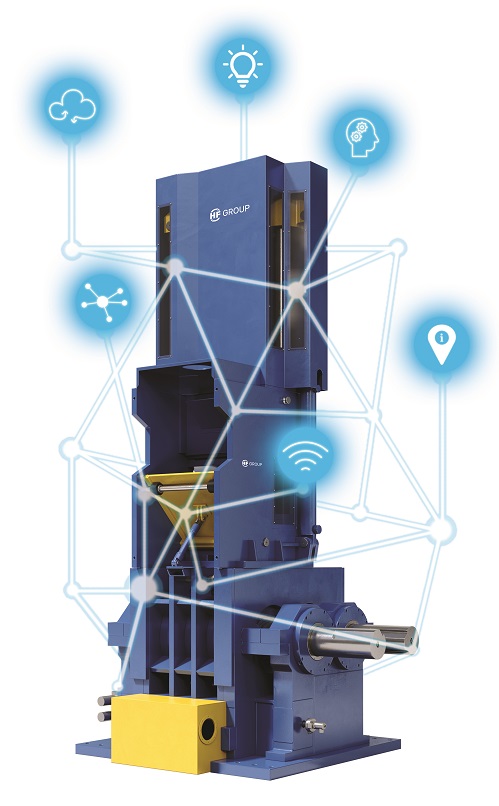 The smart mixing solution is specifically designed for HF mixers as the company has precise knowledge of the machine parameters, cooling surfaces and other mixer-specific properties. The validation trials conducted post-simulation have demonstrated cycle time reductions up to 20 percent, translating into significant efficiency gains for manufacturers.
The smart mixing solution is specifically designed for HF mixers as the company has precise knowledge of the machine parameters, cooling surfaces and other mixer-specific properties. The validation trials conducted post-simulation have demonstrated cycle time reductions up to 20 percent, translating into significant efficiency gains for manufacturers.
Moreover, the company’s smart mixing approach optimises key parameters to enhance energy efficiency and quality in the mixing process. Cycle time is a primary focus with proprietary algorithms minimising unnecessary processing steps while ensuring uniform distribution and dispersion of the curative package.
Rotor speed plays a crucial role as it must be adjusted at different phases of mixing. A higher speed may be beneficial in the initial dispersion stage, but excessive speed leads to rapid temperature increases, negatively affecting compound properties. The company’s models balance rotor speed, energy efficiency and temperature for optimal results.
Lastly, fill factor is essential for both quality and efficiency. Overfilling can result in uneven mixing and longer processing times, while underfilling reduces throughput and jeopardises batch quality. The company’s Smart Final Solution ensures that the fill factor is set to an ideal level for maximum quality and throughput.
TECHNOLOGICAL INCLUSIVITY
The company’s approach to smart mixing is currently data-driven and reliant on process specialists, but the role of artificial intelligence (AI) in this field is expected to grow. “While AI has the potential to make autonomous decisions and process adjustments in the future, we still integrate human expertise alongside digital tools to ensure process reliability. Factors such as installed downstream equipment, mixer conditions and on-site variations must be considered, which currently require operator input. However, we are already exploring AI-driven solutions such as predicting batch temperature, optimising carbon black incorporation and refining oil dispersion, which could eventually enhance process automation,” informed Spier.
While digitalisation is a key part of the company’s transformative roadmap, AI’s role is still in development. Instead of full AI automation, it employs advanced models and algorithms that run extensive simulations to optimise mixing conditions without compromising quality. These models provide real-time feedback on the best possible process adjustments, delivering improvements in efficiency, quality and consistency.
Alluding to whether older mixers installed 5 to 10 years ago can be retrofitted with recent upgrades, he noted, “There is a possibility of retrofitting smart solutions to enhance its capabilities. Rather than relying solely on AI, we offer in-line process monitoring, where historical mix data is used to establish a reference baseline with tolerance bands. This allows for real-time adjustments.”
The mixing process is fully automated with step-related control systems defining key parameters such as mixing time, specific energy input and rotor speed per step, batch temperature to ensure precision and consistency. Every mixing step can be supported by HF’s unique intelligent controller technology such as intelligent Ram control iRam, the HF constant temperature controller or iXSeal Dust Stop Lubrication Controller.
PROCESS ADAPTATION
Tyre makers are increasingly experimenting with alternative materials, such as recycled rubber and dandelion-derived compounds, which significantly impact the mixing process. Adjustments are necessary to maintain efficiency and quality, as non-traditional materials alter torque curves and require parameter modifications.
Moreover, different category of tyres requires different mixing processes due to variations in tread compound formulations. Passenger car tread compounds typically differ from OTR formulations, necessitating specific dispersion techniques to achieve the desired performance characteristics.
With that said, it is prudent that companies adapt to changing processes fuelled by market demand. “The company provides a range of rotor solutions to optimise these mixing processes. Tangential rotors are designed to enhance master batch dispersion, especially the NST rotor, ensuring uniformity in the compound. ZZ rotors are mainly used for final batch production, offering precision in mixing the final formulation. In addition, the ZZ rotor geometry has proven strong performance in Master Batch Silica Processing. Additionally, intermeshing rotors are employed to manage specialised compounds, providing better control over the mixing process for unique material requirements,” revealed Spier.
Furthermore, material innovations are significantly impacting the mixing process, requiring process adaptations to maintain efficiency and achieve consistent final results. The use of alternative materials such as recycled rubber or non-traditional sources like dandelion rubber, rCB and other recycled materials alters the torque curves during mixing. These changes necessitate adjustments to mixer parameters, ensuring optimal dispersion and processing without compromising product quality.
To support customers in navigating these challenges, HF’s process experts collaborate closely with them through the technical centre in Germany and worldwide operating process engineers. By testing new processes before full-scale industrialisation, the company helps identify and resolve potential issues in advance.
INDUSTRY SHIFTS
The shift towards premium tyres is shaping the European, Asian and North American markets differently. In Europe, manufacturers are increasingly focusing on premium and OTR tyres while scaling back production of 15–17-inch models and consolidating operations.
This shift is driving higher demand for advanced compounds and increased silica usage. However, capacity expansions remain limited with most investments directed towards equipment upgrades rather than new production facilities.
In Asia, particularly in India and China, greenfield projects are on the rise due to strong automotive demand. This expansion reflects the region’s growing role in the global tyre industry as manufacturers invest in new facilities to meet both domestic and export needs. North America, on the other hand, is seeing a mix of replacement investments and selective large-scale expansions with companies balancing modernisation efforts and strategic growth.
Beyond these key regions, North Africa, specifically Algeria, Morocco and Egypt, is emerging as a new manufacturing hub. This region is gaining traction in the global tyre industry, an area where it previously had little presence. With increasing investment and infrastructure development, North Africa is positioning itself as a competitive player in tyre production.
With many manufacturers shifting to smaller campaign to accommodate different tyre recipe, flexibility in the mixing process has become essential. HF’s automation system is designed to handle these challenges by allowing quick modifications to production plans.
Manufacturers can adjust torque, batch sizes and compound quantities without causing disruptions. Additionally, the manufacturing execution system ensures seamless execution, making even short production runs of 5 to 10 batches efficient and cost-effective.
MARKET EXPANSION
Besides Europe, Asian markets such as China and India remain key growth locations for the company. As manufacturers in these regions adopt new technologies to meet evolving industry standards, the demand for efficient and adaptable mixing solutions continues to rise.
“We continue to invest heavily in innovation and research and development to grow in the Asian market. Allocating three percent of our revenue to innovation and 4.5 percent to development, the company ensures that 35 percent of its projects focus on sustainability. By maintaining technology leadership, we deliver high-quality, high-functionality equipment that supports the growth of new and established manufacturers in the region,” informed Spier.
While HF is known for its high-precision machines used by top-tier tyre manufacturers, it also caters to tier 2 and tier 3 players. The company supplies to many smaller manufacturers.
On the context of sustainability, Spiers noted, “Sustainability is a core focus of our research and development strategy, aligning with the ambitious environmental targets set by tyre manufacturers worldwide. We integrate sustainability by developing energy-optimised mixers with efficient drive setups, introducing new hydraulic power units that significantly reduce power consumption and implementing incremental efficiency improvements such as enhanced heat management to extend machine longevity.”
Lastly, the company provides comprehensive service beyond commissioning, including operator training, process optimisation and trouble-shooting, round-the-clock support via ticket and hotline systems and fast-response local service teams across China, South-East Asia, India, North America, North Africa and Europe.
Trelleborg Tires Retains Crown As Brazil's Best Agriculture Tyre
- By TT News
- December 07, 2025

For the second consecutive year, Trelleborg Tires has earned the prestigious title of Best Agriculture Tyre at the 22nd Visão Agro Brazil Awards. This 2025 accolade, presented during a ceremony in Ribeirão Preto, highlights the company’s dedicated role in advancing Brazilian agribusiness through technological leadership and a commitment to sustainable practices. The award was received on behalf of the company by Fábio Metidieri, Agri Sales Director for Yokohama TWS Brasil.
Central to this achievement is Trelleborg’s ongoing innovation, particularly the expansion of its ProgressiveTraction technology within the TM tyre series. This engineering, featured in models from the row-crop TM600 to the high-horsepower TM1000, utilises a dual-edge lug design. The tread operates progressively on the soil to enhance traction, promote self-cleaning and minimise vibration. The resulting benefits include improved operational efficiency, increased tyre durability and superior soil protection, directly supporting farmers’ goals for greater productivity and environmental stewardship.
The company’s deep roots in Brazil, supported by a specialised local team, rigorous field testing and strong manufacturer partnerships, ensure its solutions are finely tuned to regional demands. This local infrastructure allows for responsive technical service and keeps product development closely connected to the practical challenges faced by the agricultural sector. The Visão Agro Brazil Awards, judged by a panel of industry executives and researchers, serve as a recognised benchmark for innovation and performance, making this recognition a significant testament to Trelleborg Tires’ impact on the country’s farming landscape.
Metidieri said, “Receiving this award at such a prestigious event once again reinforces our commitment to Brazilian agriculture. Our goal is to keep advancing in technology and field performance, ensuring that every Trelleborg tyre delivers real value – helping farmers operate more efficiently, sustainably and profitably. This award reflects the trust placed in our team and our products by professionals throughout the sector. It strengthens our commitment to delivering technologies that address local challenges and help shape the future of Brazilian farming.”
Premium Makeover
- By Sharad Matade
- December 05, 2025
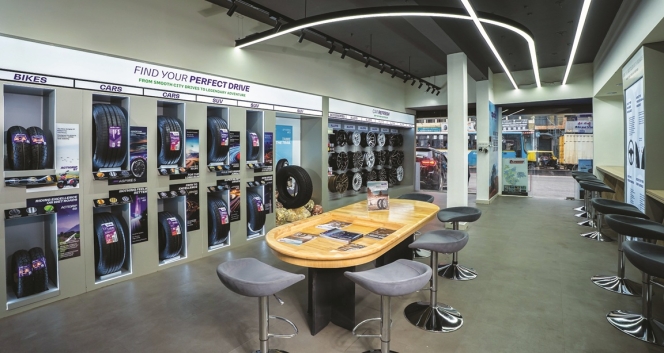
India’s tyre retail industry is undergoing a dramatic makeover, moving far beyond the cluttered workshops and transactional buying of the past. Fuelled by rising demand for premium vehicles, digital-first customers and stronger export momentum, tyre makers are transforming retail spaces into sleek, immersive experience centres. What was once a routine utility purchase is rapidly evolving into a premium, advisory-led mobility experience designed for a new generation of motorists.
India’s tyre retail scene is shifting gears, leaving behind the era of crowded workshops and impersonal counters. In their place, manufacturers are rolling out sleek, thoughtfully designed, tech-powered spaces that echo the luxury of high-end car showrooms. What started as a few bold pilots in big cities has quickly become the go-to playbook for tyre brands eager to win over a new generation of savvy, comfort-loving, digital-first customers.
From urban to rural areas, this transformation reveals a profound change in how Indians approach mobility. Today’s motorists – especially those behind the wheel of SUVs, luxury sedans and electric cars – want more than just a tyre swap. They crave expert advice, a polished atmosphere and a shopping experience that reflects the elegance of their vehicles. Once a utilitarian afterthought, tyre retail is now emerging as a coveted part of the automotive journey.
Strong OEMs and replacement demand in both domestic and export markets underpin the transition.
In FY 24-25, tyre exports from India surged by nine percent year-on-year to INR 251 billion, according to data released by the Ministry of Commerce. With an estimated annual turnover of INR 1 trillion and exports exceeding INR 250 billion, the Indian tyre industry stands out as one of the few manufacturing sectors in the country with a high export-to-turnover ratio.
Though tyre exports have hit a speed bump due to higher US tariffs on select categories of Indian tyres compared to those of competing nations, the long-term prospects for the Indian tyre industry remain strong. According to a joint report by ATMA and PwC India titled ‘Viksit Bharat 2047: Vision and Roadmap for the Indian Tyre Industry’, India’s tyre production volumes are projected to grow nearly fourfold by 2047, while industry revenues are expected to expand almost 12 times to about INR 13 trillion.
Against this backdrop, tyre makers are modernising aggressively to retain customers and build a more profound emotional affinity. The broad shift is visible in how retailers are reinventing their spaces. Lounges with crafted lighting, upholstered seating, minimalist décor and large digital walls are replacing traditional steel racks and dusty counters. Informational murals and heritage display trace decades of tyre innovation, strengthening brand storytelling. Stores increasingly feature curated experience zones where customers can explore tyre technologies, EV-compatible profiles, eco-friendly materials and performance characteristics through visual displays and interactive tools.
A clear sign of this trend is the rise of personalised, advisory-led engagement, replacing the old dependence on technicians. Retailers now profile driving habits, terrain usage, daily distance and vehicle type to recommend tyres customised to each consumer’s pattern. This service-led model is shifting the customer’s mindset from price-first decision-making to long-term value evaluation.
The new premium outlets are designed to deliver a lifestyle-driven, hospitality-grade experience rather than a traditional tyre shop visit. Customers receive personalised mobility recommendations tailored to their vehicle, driving style and needs, supported by smart service innovations like intelligent product selection, quick-fit services and digital scheduling. The space also acts as a community hub for driving enthusiasts, creating a connected ecosystem around the brand. With lounge-style comfort, immersive storytelling and specialised tyre and service packages for luxury and performance vehicles, the outlet blends convenience, premium care and brand-centric offerings into an elevated customer experience.
“Customer experience at the point of sale is another branding exercise poised to change buyer characteristics. Multi-brand outlets often commoditise the tyre-buying experience. That’s why companies are launching exclusive brand outlets with curated customer experiences. Over the next decade, new delivery models will emerge,” said Kavan Mukhtyar, Partner and Leader – Automotive, PwC India.
Apollo Tyres articulates this change as a move towards lifestyle-led retailing. Its new super-premium outlets have been built not as showrooms but as emotionally resonant spaces.

Udyan Ghai, Group Head of Marketing at Apollo Tyres, explained that the company’s new retail architecture is anchored in long-term strategic priorities: “Our move to a lifestyle-led, immersive tyre retail format is driven by our own desire for premiumisation and category leadership. We are looking at elevating tyre retail in India by setting new benchmarks and shifting from commodity selling to a premium, lifestyle-driven experience.”
He said the brand aims to ‘emotionally engage with customers, offer tailored solutions, build a community of driving enthusiasts and tap into premium segments – all while delivering a differentiated, modern retail experience’.
Ghai believes retail ambience plays a decisive role in influencing perception. “A relaxed and well-designed lounge signals comfort, trust and premium value,” he said, adding that such environments elevate tyres from a mundane requirement to a core element of vehicle care and identity.
Digital transparency, he believes, is the second pillar of modern tyre retail. “Digital systems ensure transparency and help demystify tyre selection – tread patterns, speed ratings, durability and fitment. Consumers feel less dependent on a technician’s word and more in control, which boosts their confidence and perceived fairness,” Ghai said.
Customers today are inundated with choices, and digital systems, he said, turn tyre buying into an ‘informed, personalised decision’, comparable to selecting a smartphone, a pair of performance shoes or even a detailed insurance plan. According to Ghai, this new retail model is ‘a strategic investment in the future of mobility retail’, designed to be scalable and to support community-building events, workshops and enthusiast interactions. As India moves towards EVs and connected cars, he said these premium outlets will provide EV-focused tyre expertise, interactive digital tools and personalised recommendations that appeal to younger, digitally savvy motorists.
CEAT shares a similar philosophy. Its national retail revamp focuses heavily on digital immersion, consistent messaging and design-led layouts. Lakshminarayanan B, the company’s Chief Marketing Officer, said the modernised CEAT Shoppes are fundamentally reshaping the category.

“The modern layouts and digital integration in CEAT Shoppes are revolutionising the tyre-buying experience, making it more experiential and customer-centric,” he said, adding that these updated outlets elevate the experience, build trust through uniform communication and drive decisions by reducing ambiguity around features and value.
Lakshminarayanan highlighted CEAT’s attempt to harmonise customer experience across demographics: “The approach in urban markets through premium stores, product offerings and services is to create access and aspiration for premium customers. The same is replicated in upcountry markets also.”
The CEAT Executive said the company is building for a future where personalisation will be the defining characteristic of tyre retail. “CEAT is focused to drive the future of tyre retail through end-to-end personalisation,” he said.

As experiential retail takes hold, service portfolios inside tyre stores are expanding faster than ever. Advanced wheel balancing, laser-driven alignment systems, nitrogen inflation, premium alloy wheel installations, EV-oriented tyre consultations, digital appointment scheduling and real-time tyre-health diagnostics are now standard. Many outlets also provide car detailing, interior cleaning, ceramic coating, PPF application, brake checks, battery inspections and multi-point vehicle health reports, making them full-fledged mobility centres.
Global players have pushed the envelope even further. Michelin’s 25,000-square-foot Experience Store in Nashik features a heritage wall and innovation displays showcasing electric mobility, materials science and environmental responsibility. It houses precision wheel-alignment bays, detailing studios, and accessory galleries. “We are proud to unveil Michelin’s first Experience Centre in India. The sole purpose of this store is to go beyond traditional tyre retail and provide customers with an immersive experience of the brand,” said Shantanu Deshpande, Managing Director of Michelin India.
Continental Tyres is also strengthening India’s premium retail ecosystem through its CPD outlets, which include ambient lounges, diagnostic equipment, premium alloy wheels and digitally enabled guidance. “With our new CPD store in Indore, we bring Continental’s promise of safety, innovation and comfort closer to Madhya Pradesh’s clients,” said Samir Gupta, Managing Director of Continental Tyres India. He added that the brand’s ‘In the Market, For the Market’ approach is central to its retail expansion strategy.
Even in rural markets, tyre retail is becoming more formalised, structured and service-oriented. JK Tyre’s ‘Steel Wheels’ format is targeted at towns with populations under 100,000 and offers standardised layouts, value-added services, best-in-market pricing and instant claim facilities. “Our Rural expansion programme will help us reach the interiors of the real Bharat that is economically vibrant but often underserved. We are not just building retail points; we are also enabling entrepreneurship and access,” said Managing Director Anshuman Singhania.
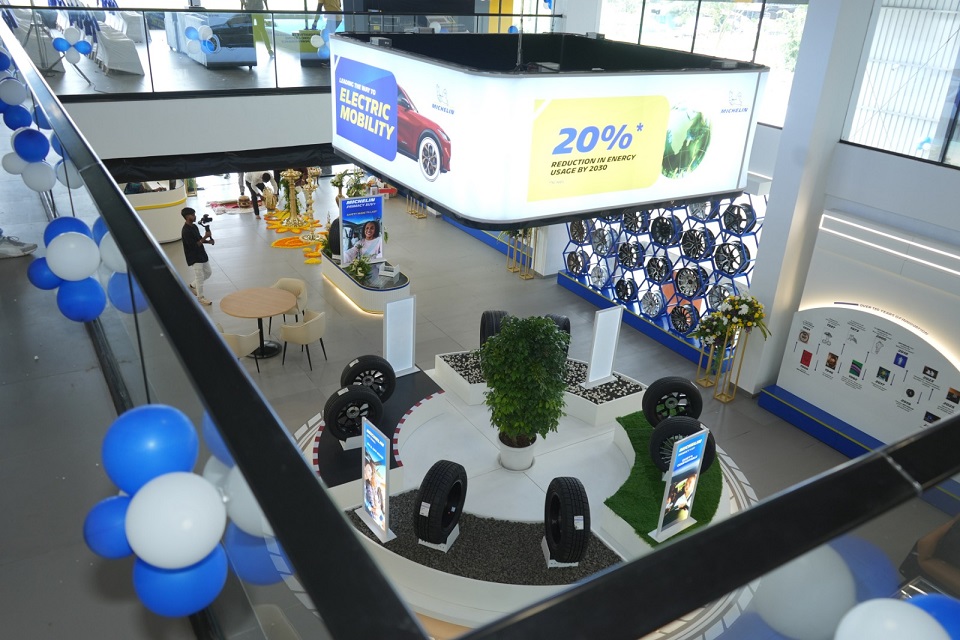 Together, these developments mark a decisive shift in how tyre brands engage customers. Tyre stores are increasingly functioning as lifestyle environments, designed for comfort, informed decision-making, personalisation, transparency and community. The industry is moving away from a product-first mindset to a customer-experience-led philosophy.
Together, these developments mark a decisive shift in how tyre brands engage customers. Tyre stores are increasingly functioning as lifestyle environments, designed for comfort, informed decision-making, personalisation, transparency and community. The industry is moving away from a product-first mindset to a customer-experience-led philosophy.
As premium cars, SUVs and EVs become mainstream, and as younger motorists prioritise digital empowerment and ambience, tyre retailers are aligning with these new expectations. India’s tyre makers are building a retail landscape where experiential engagement, technology integration, service breadth and emotional connection define long-term brand success.
For an industry long anchored in grease, metal and functionality, the transformation is profound. Tyre retail in India is no longer just about fitment; it is becoming a premium mobility experience, curated for a generation that demands clarity, comfort and an elevated relationship with every aspect of vehicle ownership.
Kumho Tire To Build First European Plant In Poland With $587mln Investment
- By TT News
- December 05, 2025
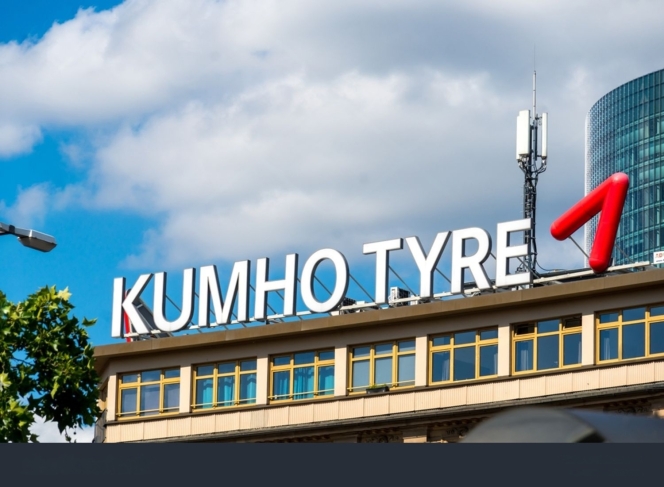
Kumho Tire will establish its first European manufacturing plant in Poland’s Opole region as the South Korean company seeks to expand its position in one of the world’s largest tyre markets.
The group said the factory is scheduled to begin initial operations in August 2028, subject to investment approval and licensing. Kumho plans to produce 6m units annually in the first phase and expand capacity in line with demand. Total planned investment is USD 587 million.
Kumho has spent recent years evaluating multiple European locations, including Poland, based on logistics, labour availability, infrastructure, market access and investment incentives. The company said Opole was selected as the optimal site owing to supply-chain stability within the EU and the region’s supportive operating conditions.
Europe accounts for about a quarter of global tyre consumption and is home to several major automotive manufacturers. The region represented roughly 26.6 per cent of Kumho’s sales last year. The company has previously relied on exports to serve European customers, which it said limited its competitiveness in the market.
The new plant is intended to strengthen Kumho’s ability to supply high-value-added products, including high-performance and larger-diameter tyres, to European vehicle makers.
Kumho currently operates eight production sites across South Korea, China, the US and Vietnam, with combined annual output of 65 millionunits. The Polish plant will complete what the company describes as a production network spanning Asia, Europe and North America.
Jung Il-taek, Kumho Tire’s Chief Executive, said: “The European market occupies a very important strategic position in the global tire industry,” adding that “Kumho Tire will go beyond simple exports and dramatically enhance premium brand value by strengthening quality and service competitiveness through local European production and supply.”
Tyre Stewardship Australia Appoints David Fraser As Chair As David Spear Steps Down
- By TT News
- December 04, 2025
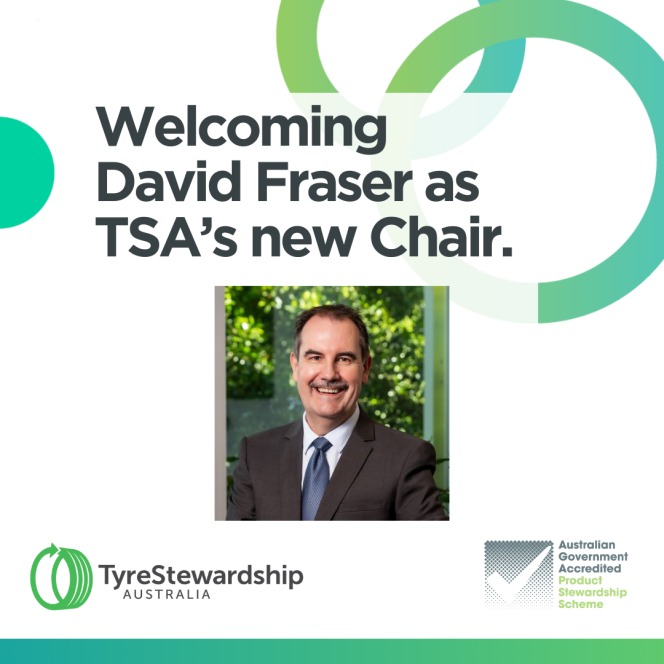
Tyre Stewardship Australia has appointed David Fraser as its new chair, succeeding David Spear after nine years in the role during a period of regulatory and industry change in the country’s tyre-recycling sector.
Spear’s departure closes what the organisation described as a challenging yet incredibly important chapter for its efforts to advance circular outcomes for Australia’s end-of-life tyres. TSA, an industry body backed by government and sector participants, oversees the national stewardship scheme and promotes recycling and re-use pathways for waste tyres, an area facing increasing scrutiny under Australia’s environmental and product-stewardship policies.
In a statement, TSA said it “thank[s] him for his unwavering support and dedication to driving circular outcomes for Australia’s end-of-life tyres”.
Fraser, a TSA director since 2023, brings experience in governance and compliance. He joins at a time when Australian states are tightening environmental standards and seeking to reduce landfill through higher recycling targets. TSA said Fraser has “deep understanding of our strategy, our challenges and the opportunities ahead”.
The organisation added: “We look forward to his leadership as TSA enters its next chapter.”
TSA also expressed appreciation to Spear “for your contribution and support of our mission”, and welcomed Fraser, saying it is “excited and ready for what lies ahead”.


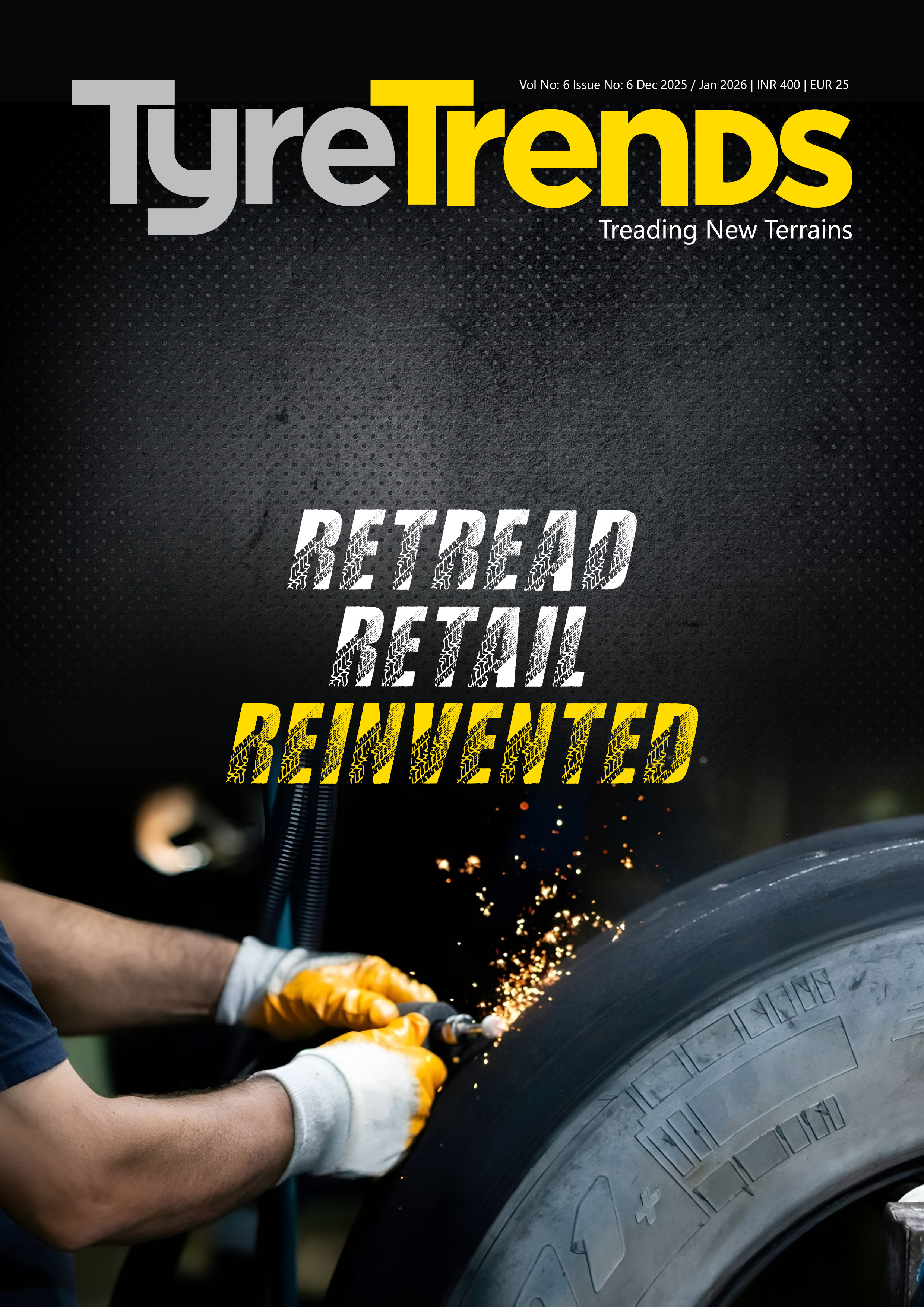

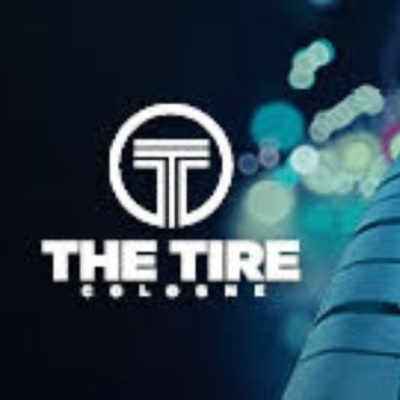
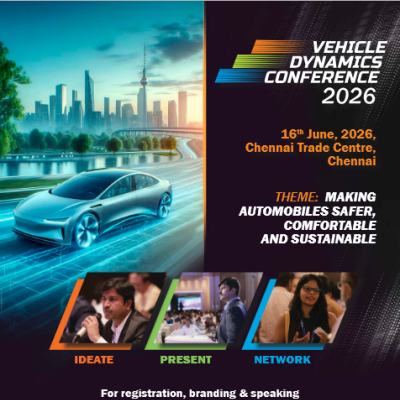

Comments (0)
ADD COMMENT